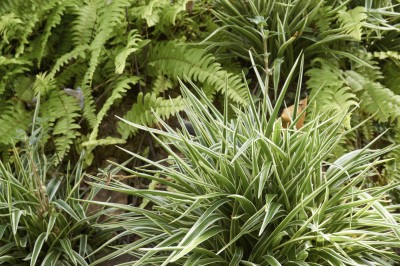






Most people are familiar with spider plants as houseplants because they are so tolerant and easy to grow. They tolerate low light, infrequent watering and help clean indoor air, making them very popular. They also propagate easily from the little plantlets (spiders) that grow from their flower stalks. One small spider plant can very quickly lead to many more. You may have wondered at one time or another, “can spider plants be outdoors?” Well, in the right conditions, growing spider plants outdoors is possible. Read more to learn how to grow a spider plant outside.
The easiest way to grow spider plants outside is just to move your potted spider plant outdoors when weather permits and indoors when it is too cold. Spider plants make excellent plants for hanging baskets, with small white, star-shaped flowers arching down on long flower stalks. After flowering, grass-like new little plantlets form on these flower stalks.
These little spider-like hanging plantlets are why Chlorophytum comosun is commonly called spider plant. The plantlets are like the runners on strawberry plants and will root wherever they touch soil, creating new spider plants. To propagate, simply snip the “spiders” off and stick them in soil.
Native to South Africa, spider plants need a warm, tropical climate to survive outside. They can be grown like a perennial in zones 9-11 and as an annual in cooler climates. Spider plants outside cannot tolerate any frost. If planting them as annuals in cooler climates, be sure to wait until there’s no danger of frost.
Spider plants prefer filtered sunlight, but can grow in part-shade to shade. They tend to get sunburnt in full sun or afternoon sun. Spider plants outside make excellent spreading groundcovers and border plants around trees. In zones 10-11, it can grow and spread aggressively.
Spider plants have thick rhizomes that store water, making them tolerate some drought. Spider plants can also make excellent trailing plants for large container arrangements.
Growing spider plants outdoors can be as easy as growing them inside. Start them early indoors, giving the roots time to develop. Spider plants need well-draining, slightly acidic soil. They prefer dappled shade and cannot handle direct afternoon sun.
When young, they need moist soil. Spider plants are sensitive to the fluoride and chlorine in city water, so they perform best with rain water or distilled water.
They also don’t like too much fertilizer, use a basic 10-10-10 fertilizer only once a month or bi-monthly.
Spider plants outside are especially susceptible to aphids, scale, whiteflies and spider mites. Use an insecticidal soap, especially if they are being brought inside for the winter. I use a homemade dish soap dip, made from ¼ cup Dawn dish soap, ½ cup mouth wash and a gallon of water.
If growing spider plants outdoors as an annual, you can dig them up and over winter them in pots inside. If you have too many, give them away to friends. I have planted them in Halloween cups and handed them out at Halloween parties, telling kids they can grow their own creepy spider plants.
Ways How To Care For Spider Plants
How to Grow and Care for Yesterday-Today-and-Tomorrow Plant
Snake Plant Info – How To Grow A Snake Plant And Snake Plant Care
Spider Plant Care: Gardening Tips For Spider Plants
Do Spider Plants Need Fertilizer – How To Fertilize Spider Plants
Pruning Spider Plants – How To Trim Spider Plant Leaves
Growing Wandering Jew Outside: How To Plant Wandering Jew Outdoors
Copyright © www.100flowers.win Botanic Garden All Rights Reserved